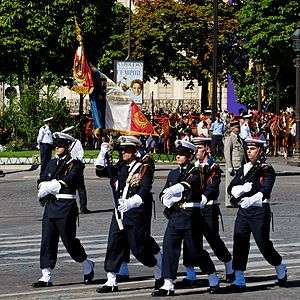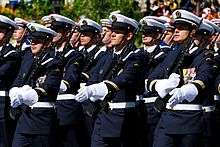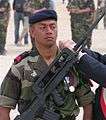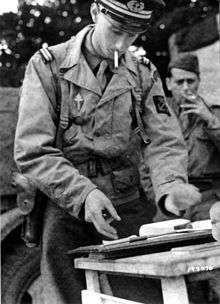Fusiliers Marins

The Fusiliers Marins ("Naval Fusiliers") are units specialised in the protection and defence of vessels and key sites of the French Navy on land. They consist of about 1,900 men.
Structure
The current structure of the Fusiliers Marins is :[1]
- Groupement de fusiliers marins of Toulon (sized as battalion) with 3 companies in the naval station of Toulon and one in each of the navy communication stations of France Sud and Rosnay.
- Groupement de fusiliers marins of Brest with 3 companies in the naval station of Brest, one in each of the naval air stations of Lann Bihoué and Lanveoc Poulmic and one in the navy communication stations of Sainte Assise.
- Compagnie de fusiliers marins of Cherbourg (protection of the naval station of Cherbourg)
- Compagnie de fusiliers marins of Île Longue (base of the French ballistic missile submarines)
- Detachments also protect interarm transmission stations (in French Polynesia, Martinique, French Guiana, New Caledonia, Reunion and Senegal), the French naval base in Abu Dhabi, the Combat Training Center at Arta Beach in Djibouti and the port of Djibouti.
- Boarded security teams are permanently deployed in Djibouti, Mahe (Seychelles) and in the Guinea gulf.
Missions
The Fusiliers Marins are tasked with :
- protection of sensitive naval sites
- protection of ships and onboard security
- mentoring boarding-landing parties
- military instruction in French naval ships and schools
- reinforcing the protection of any particular installation or ship
- supporting operations of the Commandos Marine
History
| |||||||||||||||||||||||||||||
In 1627, Richelieu founded the Régiment de la Marine. It was to provide onboard troops capable of fighting on land or on sea, and commanded by the officers of the ship. These troops were part of the crew, and helped with navigation.
The base unit was the 70-man company, compagnie détachée de la Marine. It was commanded by a lieutenant des vaisseaux du Roi ("Lieutenant of the Ships of the King") and two ensigns. These companies fought in all French colonies, particularly in Nouvelle France. An anonymous Fusilier de Marine is credited for Nelson's death during the Battle of Trafalgar.
In 1825, a royal decree abolished the Régiments de la Marine and imposed that landing parties (compagnies de débarquement) should be composed of sailors. The tradition of the Régiments de la Marine later gave birth to the Troupes de Marine (Troupes Coloniales), specifically raised for overseas service, of the French Army.
As the crews of the ships lacked personnel trained for fighting on land, the imperial decree of 5 June 1856 created the specialisation of marin fusilier. The Fusiliers-Marins was initially composed of sailors and naval officers who were sent for special infantry training in Lorient in order to form the marine detachments aboard ships and conduct small scale landings. This was not the first time that the French had tried this approach. Before the First Republic, the Corps royal de l'infanterie de la marine had been superseded by the Corps royal de canonniers-matelots on 1 January 1786.
These troops were notably engaged during the war of 1870 and the defence of Paris. Two battalions of Fusiliers-Marins, under the respective commands of capitaines de frégate Laguerre and de Beaumont, took part in the Tonkin campaign as part of the Tonkin Expeditionary Corps, distinguishing themselves at Son Tay and Bac Ninh. In 1900 they participated in the fighting during the Boxer Rebellion and it was in the same year that the fusiliers were finally confirmed as part of the naval service as their counterparts in the troupes de marine (troupes coloniales) moved on to the Army via the War Ministry.
In World War I, their famous defense in 1914 of Diksmude in the Battle of the Yser stands out. They also served at the Dardanelles and in Macedonia.
The fusiliers-marins were busy studying amphibious warfare, testing experimental landing craft and taking part in exercices combinés from the late 1920s until the mid-1930s.
In World War II, their most famous battles were Bir Hakeim and Normandy. World War II Fusiliers-Marins units included the 1er Regiment de Fusiliers-Marins de Reconnaissance which served in the 1st Free French Division (1er DFL), the Régiment Blindé de Fusiliers Marins (RBFM) of the 2nd Armoured Division and the 1er Bataillon de Fusiliers Marins Commandos (1er BFMC) who served in 10 (Inter-Allied) Commando. Today's Commandos Marine are drawn exclusively from the ranks of the Fusiliers-Marins after passing rigorous selection.
In Indochina after World War II, the French Navy and Fusiliers-Marins created the famous riverine warfare units called divisions navales d'assaut (naval assault divisions), commonly referred to as dinassauts. The Demi-Brigade de Fusiliers-Marins (DBFM) which included the Bataillon d'Intervention de Fusiliers-Marins (BIFM) served in Algeria.
 "Call to fair men; the Royal regiment of Naval fusiliers is recruiting..." Louis XV
"Call to fair men; the Royal regiment of Naval fusiliers is recruiting..." Louis XV Musée de la Marine, Paris: Naval Infantry shako, around 1829.
Musée de la Marine, Paris: Naval Infantry shako, around 1829. Fusiliers marins decorated after the Battle of the Yser.
Fusiliers marins decorated after the Battle of the Yser. Inspections at sea are often carried out by fusilliers marins
Inspections at sea are often carried out by fusilliers marins
Uniforms
The Naval Fusiliers wear a dark blue beret in their combat dress uniforms, pulled right with their own distinctive badge worn over the left eye or temple. Along with the Naval Commandos, they are unique among French forces in wearing the beret this way. When wearing regular dress uniforms, the sailor cap is used by junior ratings and the peaked cap by senior petty officers and officers.
 Parade uniform
Parade uniform Summer parade uniform
Summer parade uniform Standard combat clothing
Standard combat clothing Fusiliers Marins Beret Badge
Fusiliers Marins Beret Badge- "Fusiliers Marins" insigna
- Fusiliers Marins parading with the sailor hat worn with camouflage uniform
Equipment
Weapons used

Assault Rifles
- Famas G2 assault rifle
Sniper Rifles
Shotguns
- Valtro PM5 M2 shotgun
Pistols
Non-lethal
- Alsetex "Cougar" 56mm grenade launcher
- X26 Taser weapon
Machine Guns
Rocket Launchers
- AT4CS Anti-Tank Weapon
Inflatable boats
- Zodiac Hurricane 630 IO EDOP
- Zodiac Futura Mark II
- Zodiac Futura Mark III
Ground vehicles
- Light tactical vehicle Land Rover Defender 90 Td5
Notable fusilier marins

- Admiral Philippe de Gaulle, the son of the general Charles de Gaulle
- Lieutenant Commander Henri de Pimodan, famous resistant died in deportation
- Lieutenant Commander Robert Detroyat, first commandant of the legendary 1st battalion of Fusilier marins, died during operation Exporter in Syria (1941)
- Quarter-master Theo "Dudu" Dumas, a popular figure who appears in the film un taxi pour Tobrouk played by Lino Ventura
- Quarter-master Constant Duclos, the first French soldier to execute a parachute jump on November 17, 1915
- Lieutenant Georges Hébert, a pioneering French physical educator, theorist and instructor
- Sub-Lieutenant Paul Henry, fusilier marin officer died defending the legation quarter of Peking (1900)
- Lieutenant Pierre Guillaume, a famous fusilier officer of the French Indochina war, inspired the character of the "Drummer Crab", the hero of the French movie Le Crabe-tambour
See also
Notes
- ↑ "Protection défense la réforme en marche". Cols bleus. Retrieved 2016-06-25.
References
- M. Alexander, France and the Algerian War, 1954-1962: Strategy, Operations and Diplomacy, Routledge, 2002, ISBN 0-7146-8264-0 or ISBN 978-0-7146-8264-8.
- René Bail., DBFM, demi-brigade des fusiliers marins, Rennes : Marines, 2007, ISBN 2-915379-57-2 or ISBN 978-2-915379-57-0.
- Edward L Bimberg, Tricolor over the Sahara the desert battles of the Free French, 1940-1942, Westport, Conn.: Greenwood Press, 2002, ISBN 0-313-01097-8 or ISBN 978-0-313-01097-2.
- Fleury Georges, Les fusiliers marins de la France libre, Grasset, 1980, ISBN 2-246-09659-6 or 978-2-246-09659-7.
- Major general USMC Paul J.Kennedy, Dinassaut Operations in Indochina: 1946-1954, 2001.
- Contre-Amiral Robert Kilian, Les Fusiliers marins en Indochine : La Brigade marine du corps expéditionnaire d'Extrême-Orient, septembre 1945-mars 1947, Berger-Levrault, 1948.
- Charles W. Koburger, The French Navy in Indochina: Riverine and Coastal Forces, 1945-54, Praeger, 1991, ISBN 0-275-93833-6 or ISBN 978-0-275-93833-8.
- Amiral La Roncière-Le Noury, La marine au siège de Paris, Plon, 1872.
- Georges Le Bail, La Brigade des Jean le Gouin; Histoire documentaire et anecdotique des Fusiliers marins, Paris, 1917.
- Adolphe Auguste Marie Lepotier, Les fusiliers marins, Editions France, 1962.
- L’évolution des opérations amphibies, La Revue maritime, n° 198, avril 1963, p. 424.
- Raymond Maggiar, Les fusiliers marins dans la division Leclerc, du débarquement en Normandie, en passant par Paris et Strasbourg jusqu'à Berchtesgaden, Paris : Albin Michel, 1947.
- Raymond Maggiar, Les fusiliers marins de Leclerc: une route difficile vers de Gaulle, Editions France-Empire, 1984, ISBN 2-7048-0341-2 or ISBN 978-2-7048-0341-5.
- Jean Pinguet, Trois Etapes de la Brigade des Fusiliers Marins - La Marne, Gand, Dixmude, 1918.
- Marcel Vigneras, Rearming the French, Office of the Chief of Military History, Dept. of the Army, US, 1957.
External links
| Wikimedia Commons has media related to Fusiliers marins. |
- (French) Présentation des fusiliers marins et commandos marine
- 'Dixmude' an Epic of the French Marines
- The Play-Boys of Brittany Les Fusiliers Marins
- DES DARDANELLES À NARVIK La réflexion sur les opérations combinées dans la marine française (1915-1940)
- Ecole des fusiliers marins et Commandos Marine / Lorient
